Extra-Thematic Levels: Mini-Theme & Isolated Concepts
Mini-Theme: Vertical Levels (Vanilla Secret 1, Gnarly)
Even excluding water levels, there are more than a few sections in Super Mario World that feature vertical progression, where Mario has to go upwards instead towards a goal of moving left to right. We�ve already covered the levels that feature a fence-like mesh, mostly as sub-sections of the periodic enemies theme. Generally, those levels don�t do anything interesting. Part of the problem with vertical levels may be that the mechanics of the game allow only a small amount of possible content. Compared to its historical peers, Super Mario World was overflowing with game mechanics, enemies, environments and player abilities. That said, the design team did a good job keeping Super Mario World from becoming too bloated with mechanics. The vertical levels in Super Mario World show where the design team scraped up against the edges of their design, and this mini-theme (as it were) shows it. The two levels in this mini-theme are Vanilla Secret 1 and Gnarly, which have a lot in common. The second half of Morton�s castle is also a vertical climb, but it fits into the moving targets theme very well, and has little in common with the two levels analyzed below.
What the design team found in vertical levels is that they make for interesting open mazes. By this I mean that in both these levels there aren�t too many walls, because gravity does the work of a wall in preventing Mario from reaching certain parts of the level. The best example of this in Vanilla Secret 1 is this section, where the player needs to move a springboard to the right location in order to access an obvious but distant pipe.
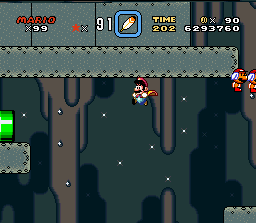
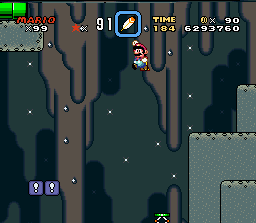
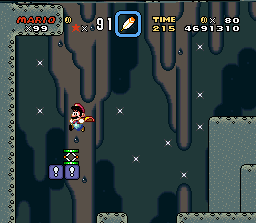
As it is in many other places, it�s possible for an experienced player to �cheat� with the cape and reach this without the springboard, although it�s one of the harder game-breakers to perform, because the platform is so short. Springboarding from the high platform won�t work because of the ceiling, and it won�t work from the other platforms available as they are too far below. A big part of this puzzle is merely realizing that it is a puzzle, and that springboard placement is the key. Of course, this requires that the player has completed the Blue Switch Palace. It�s rare for a level to require a switch palace other than its native one (i.e. yellow for Yoshi�s Island, red for Vanilla Dome). Star World 5 does the same, although both instances can be circumvented by flying. Still, it�s an odd choice, which makes me wonder if this level was one of the last to be made; certainly, the unusual puzzle aspects would make sense in that scenario.
Gnarly does more than Vanilla Secret 1, as it should considering its position in the game, but it also shows the limits of what the designers could do with vertical design in this game. In Vanilla Secret 1 there are climbable vines, springboards of various kinds and plenty of patrolling Wing Koopas. Gnarly uses plenty of springboards and adds the motorized rope but it doesn�t do a ton with either of those things. The really interesting things all happen in the vines. These four vines actually contain a puzzle.
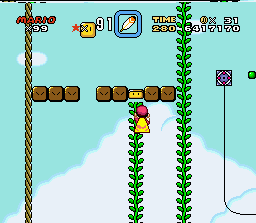
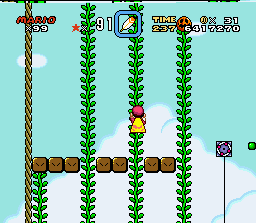
By destroying this block, the second vine can climb significantly higher, leading to an extra life. This is an interesting puzzle, and uses all elements which are already familiar to the player. It�s an easy intuitive leap to figure this puzzle out, but only once the player has actually seen the area where the puzzle takes place. There�s nothing a player can do to refresh the vines in this level (although going into a pipe would reset the vines if it were an option), and so the puzzle is a one-time offer, at least per level. Certainly, the designers could have inserted some kind of reset button unique to this level, or offered a pipe loop at the bottom of the level. The first option, though, would involve the designers adding largely superfluous mechanics, which isn�t something Nintendo�s team did too often in the early 90s. The second option would involve dropping all the way back to the bottom of the level on every puzzle attempt, which is also something that doesn�t fit with the design team�s style. Essentially, the designers could have done more with the vine puzzle here, but not without changing their game in a larger way, and so they simply obeyed the established borders of their design.
The second puzzle is similar in that it involves a common level design element elaborated in an unusual way. In order to access the hidden Yoshi Coins for this level, as well as several hidden extra lives, the player has to find a way to ferry this P-Block up to the divider in the level to take advantage of the short timer and enter the otherwise inaccessible pipe.
It�s not an easy set of jumps because of the narrow landing and enhanced momentum, but a cape helps. The only real criticism I have of this puzzle is that this is one of the least-known secrets in Super Mario World, because the P-block is so far away (in terms of the time it takes to navigate the tricky jumps) from the part of level it meaningfully modifies. That said, if there is an appropriate place for complicated, atypical puzzles, the Special zone is it. It�s not a repeatable lesson that would work in modern games (how easy is it to just Google these things, these days?), but it does adhere to the design principles of the game, so it deserves mention.
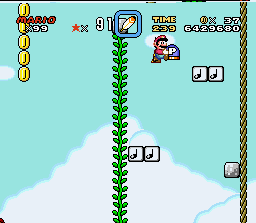
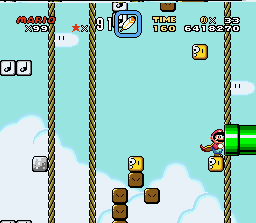
In both cases, the player ends the level by facing off against an enemy in a raised position that hurls intercepts. It�s plausible that this is a coincidence, or a product of general principles that the design team was following during the project. My theory, however, is that these levels were designed alike because one is a direct evolution of the other, along (mini) thematic lines.
One last note on this mini-theme: I don�t just group these levels together because they are vertical and employ a few of the same tricks. They also both end with an oddly similar challenge. You can see what I mean here:
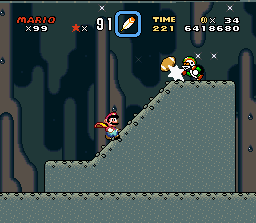
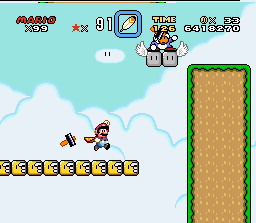
Irregular Levels: Isolated Concepts
STAR WORLD 1
One of the things we've seen several times in this analysis of Super Mario World is the technique of rewarding the player with easy fun. Obviously, this is a game, and so the whole thing is supposed to be fun. It's also not a niche game, so the whole thing is supposed to be fairly easy. But ease and fun are both relative concepts here. Star World 1 conveys a sense of what we might call �silliness� in gaming, a feeling which arises out of a minimal amount of danger. Danger is essential to a platformer; that is to say, without some risk, the game isn�t a game. Obviously, there can be too much danger so that the playing of the game feels withering, especially to first-timers. Anything short of that kind of abrupt discouragement can be fun. Indeed, sometimes the closer a level comes to this level of frustration (without actually being so), the more fun it is to beat that level. But at other times, it�s nice to play a level that�s tame and short, and only has enough danger to keep the player�s attention.
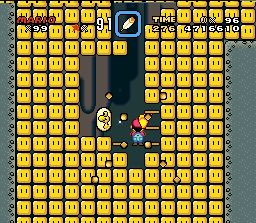
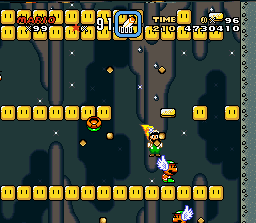
Star World 1 has no bottomless pits. It has few enemies, and all of them are eminently avoidable. It offers numerous powerups, coins and the opportunity for extra lives. And all of the level is navigated by ridiculously long chains of spin jumps. It�s also got the most super stars of any level, and they�re all close to one another. It�s a kind of bonanza, where the player can indulge several �what-if?� impulses at once.
The artistry in this level isn�t merely that it�s a silly level with a jackpot of powerups located at the bottom. The artistry is in the level�s placement in the game. Nearly a quarter century of exposure (and, more recently, the existence of YouTube) has obliterated all of the game�s secrets. Once upon a time, though, a player would have been pretty proud of discovering the Star Road, and felt perhaps both relieved and somewhat tired after the effort. It might have been doubly so because the fight with Big Boo was abnormally placed. This level, with its lighthearted gameplay makes the perfect denouement to that tension.
STAR WORLD 3
Star World 3 does something that seems totally commonplace to players and designers today, but which was actually rather unusual back then. Star World 3 features a one-challenge level. In the age of casual games, online flash arcades and indie niche titles, a one-challenge level is a part of the design vocabulary. It makes sense, too: why not break up levels into obviously discrete chunks which can be digested in small sessions? It also works for skill development via repetition, as it�s quick to load and quick to retry.
This level looks exactly like the kind of phenomenon described above, and it operates similarly, too. Here, the player�s goal is to get into Lakitu�s cloud by knocking him out of it with a kicked block.


This is a skill which is very specific and rarely used, and therefore perfect for a one-challenge level. This challenge reflects upon the game as a whole in a really meaningful way, though: each individual skill in Super Mario World is useful in so many different contexts. Consider how many contexts there are for the back jump, the cape glide, the limited height jump and so on. Part of the way that players remember a game is by playing it again and seeing how far their skills have come. The ability to overcome challenges in the game using several different skills in improvisatory combinations makes Super Mario World feel like a world with its own rules rather than just a game that can be solved algebraically. Much of the magic of videogames, and the way that they differ from analog games, is in the wholeness of the world. Because a videogame like Super Mario World is so filled with the possibility to improvise, modify and wander, the game feels incredibly coherent and wonderfully complete. The interchangeable (but not equivalent) skills are the feelers which transmit this completeness to a player.
This is not to disparage short levels or discrete modules of content; they definitely have their place in game design, platformers and even in this game. It�s just that Super Mario World is doing something very different, and playing this level after playing all the others illustrates how different it is.
DONUT PLAINS 1
Donut Plains 1 features a number of challenges that do not fit neatly into any of our classifications. We don�t really see a standard progression of evolutions, expansions and so on, although the challenges do change across the course of the level. Principally, this is because Donut Plains 1 has more in common with the game�s first two levels than it does with any of the rest. The goal of this level is to show the player how to use the cape powerup, and so we see some great tutorial challenges and a steady back-and-forth composite rhythm. The level begins by forcing the player to fly. Leaping to avoid the projectiles from the first Pitching Chuck will lead to this:
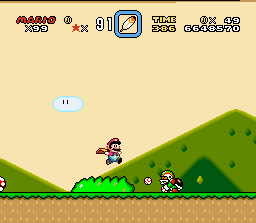
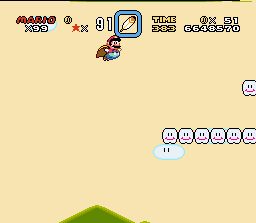
Much like in Yoshi�s Island 2, there�s a lot of extra space for the player to run through before the next challenge. The difference here is that this space allows Mario to easily gain enough speed that any jump will cause cape-flight. The Pitching Chuck presents a hazard that requires a jump, and therefore the designers �trick� the player into flight. Naturally, the design team has placed a platform in the sky that confirms the propriety of the soaring leap, and shows that cape-flights can often be rewarding and fun. The level is actually filled with extra opportunities to do the same, although the design team doesn�t really go out of their way to coerce the player into flight as they do here. This idea also doesn�t really develop across the course of the level, which is why this level isn�t included in a theme.
The designers spend the rest of the level reinforcing the many other basic skills associated with the cape. For example, the level declines sharply toward action in these two spots, featuring the Volcano Lotus.
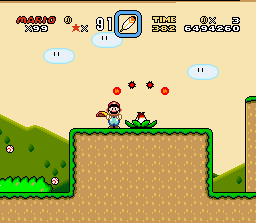
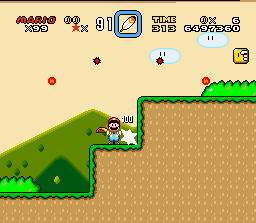
The arc of the Lotus�s fireballs precludes all but full-momentum cape-jumps, which aren�t easily possible in either location without foreknowledge of the challenge and a concrete plan. What the player is forced into doing is using the lateral cape attack. This, obviously, is a key skill that the player will need to know to use the cape in action situations throughout the rest of the game, although this is a very limited, introductory context for the skill.
This level also does a great job of isolating the most common cape-based skill: the gliding descent. Because of the way jumping to max height works (the player has to hold the jump button, which is the same technique for gliding), cape gliding is very intuitive and will happen before these challenges. What the designers do is to expose the player to the specific context for more nuanced cape glides. The first example is here:
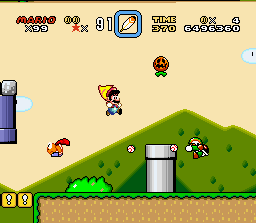
The rapid approach of the Super Koopa will likely force a jump out of the player while Mario is still in stride. The baseballs thrown by the Chuck behind it will necessitate a cape glide, while the Leaping Pumpkin Plant will act as the upward limit of the glide�s trajectory. The Pumpkin Plant also necessitates a quick dismount from this pipe and the buildup of some new momentum to outrun the Chuck�s baseballs when he turns to follow Mario. This is a wonderful introduction to a cape glide technique the player will be seeing all game. Frequently, and especially in preservation of momentum theme levels, the player will have to glide Mario to a landing spot before immediately taking off into a full-momentum stride, and this level forces the player to do just that without being too difficult. In essence, the designer is �tricking� the player into learning a technique.
There are other examples of the level reinforcing these skills, but they only do just that�reinforce them. While the first two levels of the game do a good job of displaying skills, this level is the best in the game for forcing the player into the precise situations which will expose the use of skills that will last the whole game.
GROOVY
Groovy is about the action uses of Yoshi, as directly as any level can be �about� some single idea in this game. To that end, most of the places where a platforming solution would ordinarily be possible, this level offers only an action solution. The principal implement the designers use to accomplish this emphasis on action, and Yoshi in particular, is the Pokey. The Pokey has, throughout, been featured exclusively in levels that offer Yoshi within them. Until this point, however, the player hasn�t seen any complications that would prevent Mario from simply jumping over them. In Groovy, the Pokey never makes for an easy jump; Mario needs momentum to get his feet clear of a five-block height, and even then, if the arc isn�t right, he can take damage going up or coming down.
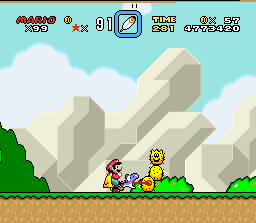
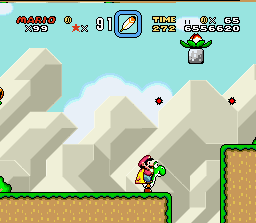
These are the two elements that constitute a standard challenge in this level. Added together, they make it essentially impossible for Mario to get up and over a Pokey safely. Thus, you could call the challenge pictured below and left the standard challenge. Here, the player could conceivably jump to safety, but it�s much easier to just use Yoshi�s tongue.
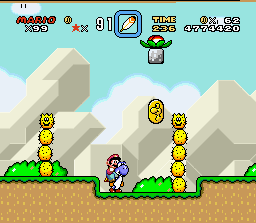
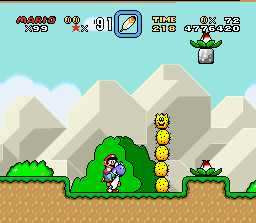
On the right is the expansion/evolution of that challenge, in which the available space is contracted, the geography changes putting Mario at a height disadvantage, and the number of Volcano Lotuses goes up. Combat is necessary not once but twice, as it�s still a tough jump with the Pokey gone.
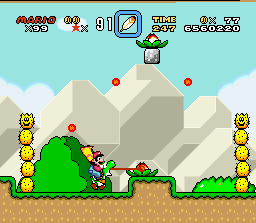
It�s much easier to do a small hop and have Yoshi eat the bottom Lotus than to try and time the jump between them, especially with the Pokey coming from the other side and the fireballs descending from above.
There are several more situations that force action uses of Yoshi out of the player. The next one, chronologically, is a different evolution of the standard challenge. This (below, left) is about as obvious as the game gets, in terms of telling the player what he or she needs to do.
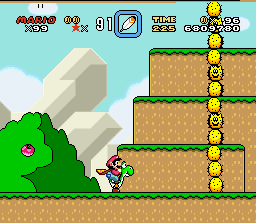
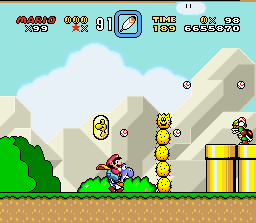
The challenge on the right, meanwhile, is a direct evolution of the double-Lotus challenge from before. This time, the Lotuses become the much more dangerous Pitching Chucks. The need to dispose of that Pokey is just as great as ever, though, as getting over him in a single bound will end in a face-full of deadly, pixelated baseballs.
Interestingly, this is another one of those few levels that actively prevents sustained flight. There are numerous (at least four) blocks hidden just above the visible screen that stop Mario�s progress if he tries to fly indefinitely over the level. It seems even the designers realized (and even admitted, in a sense) the biggest flaw in their game, albeit late in the process when they were crafting the weirdest final levels. It makes sense, in the context of this level, that only Yoshi-based combat can get the player through, and all exploits to circumvent this have been eliminated.
THE INTROS - YOSHI'S ISLAND 1 & 2
After much examination, my analysis of the first two levels in the game is that while they display no particularly inspired design ideas, it would have been inappropriate for them to have done so. In SMB3, the first level of the game featured all of the frequent powerups and gave the player the opportunity to use all of the most common mechanics in the game at once. Considering the many less-used powerups, and the vast array of weird, beautiful and unwieldy levels in that game, this haste makes sense (to say nothing of the generally greater difficulty of NES games). Based on the overall style of Super Mario World�all of its carefully delineated skill themes and gradually ascending complexity�it wouldn't make sense to have the player dive into something complex too quickly. So while the first two levels are boring from the point of view of a design study, that dullness is necessary for a game that wants to make itself accessible to a wide audience.
Yoshi's Island 1 does a good job of introducing a variety of terrain types that will be important in challenges throughout the game. The most obvious terrain type is the 45-degree terrain, which is present right at the beginning and then again a couple of screens later.

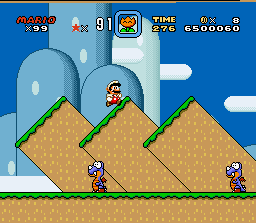
Obviously, there are many times when the player will need to have mastered angled terrain so thoroughly that evolution challenges that involve it are "about" the evolution, and not the terrain. Similarly, this level does a good job of introducing small and destructible blocks.
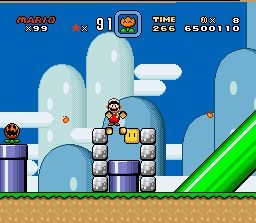
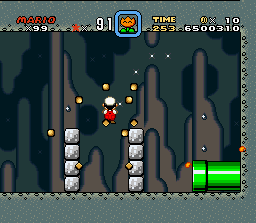
The pipe below the blocks on the left makes it obvious that they're destructible, and their insulated position shows the player how (i.e., from above) to destroy them. Meanwhile, the second challenge pictured shows the spinning property of these blocks when hit from below--but it also highlights some of the game's physics. Because of the fundamental differences in jumping in Super Mario World versus SMB3 (or a completely new player's gross inexperience), landing this jump is an essential exercise in how momentum and jumping mechanics will work for narrow targets.
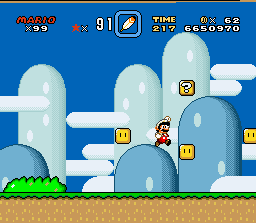
By way of another example, the mystery coin-block in the sky, pictured above is an incentive, while the lack of nearby enemies or pitfalls acts as the training-wheels that allow the player to try this fearlessly (if not without some frustration).
One other unexpected thing in Yoshi�s Island 1 leaps out: it features unusual enemies. The Rex, Snapping Chuck and Banzai Bill are not seen many places in the rest of the game, but their presence here seems to make sense for players with no skills. The Banzai Bill is big but its placement seems to suggest that it�s an object lesson in avoiding enemies:
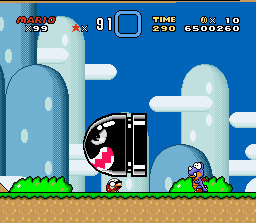
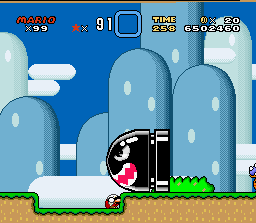
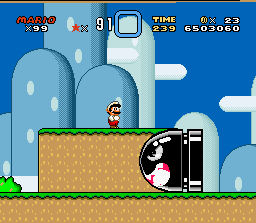
It�s easy in each of these cases either to duck or jump to a higher platform; in fact it�s often unusually hard to hit the enemy! The Chuck and the Rexes make sense in a different way; the Rexes are very similar to Koopas in terms of height and the fact that Mario usually has to jump on them twice to defeat them (at least if not using fireballs or the cape), but they lack the bouncing shell of a Koopa. The Snapping Chuck is also one of the easier varieties of Chuck, especially in this context.
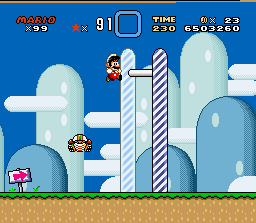
One simple enemy-bounce off his head and the player is through the gates and out of danger.
One sweeping truth about both levels is that they�re exceptionally wide. That is, not only are they long levels with big timers, but they have lots of space between challenges. Ostensibly, this is to give the player a cool-down between events, and probably also to make the player feel like he/she is accomplishing more �game� per challenge solved. It depends how one measures (as all things do in live-action games without discrete rooms) but there are at least eight full screens of space in Yoshi�s Island 2 that have no enemies or pitfalls in them.
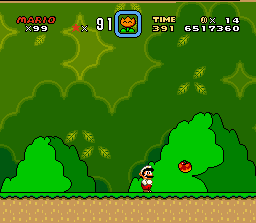
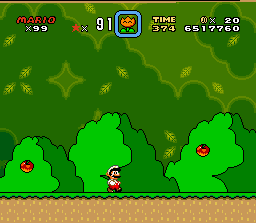
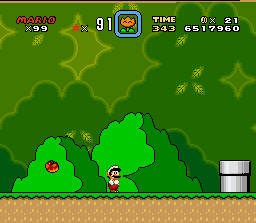
The pitfalls are particularly neutered in this level; they do appear but there�s never a challenge with a d-distance greater than two. All this �preparation� distance helps when doing things like encountering the first standard Chuck or the Koopas on the ground. There are plenty of other things introduced, like the Monty Mole and the Piranha vine�but none are as important as Yoshi. Although the Yoshi Fruits never amount to anything important in the game, their use in this level makes a lot of sense. You can see how they encourage the player to jump with a variety of simple trajectories:
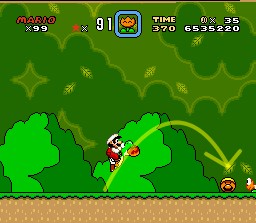
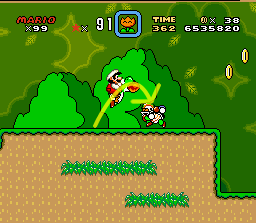
The jumps these fruits suggest even include a good approach vector to hitting the Chuck on the head.
These two levels don�t do anything very interesting, or even anything particularly clever, because they weren�t meant to do so. As far as interesting �introductory� levels go, Donut Plains 1 is a fantastic example, although I can�t tell if the more intricate things done by that level would have been reasonable if they had come first in the game, before levels like these two.